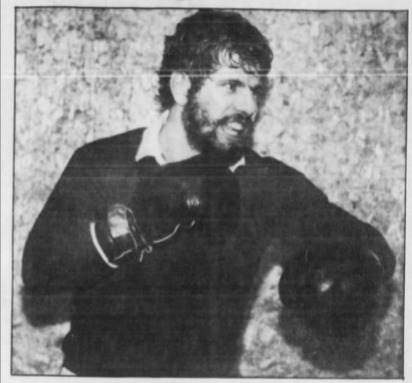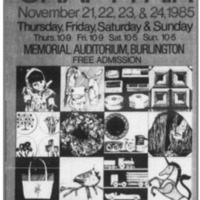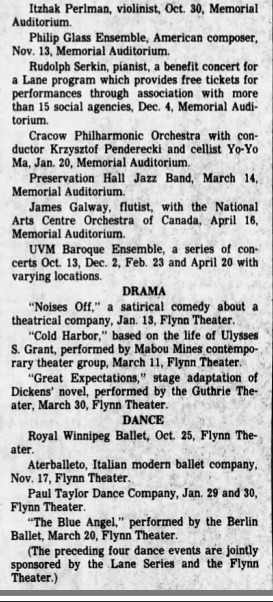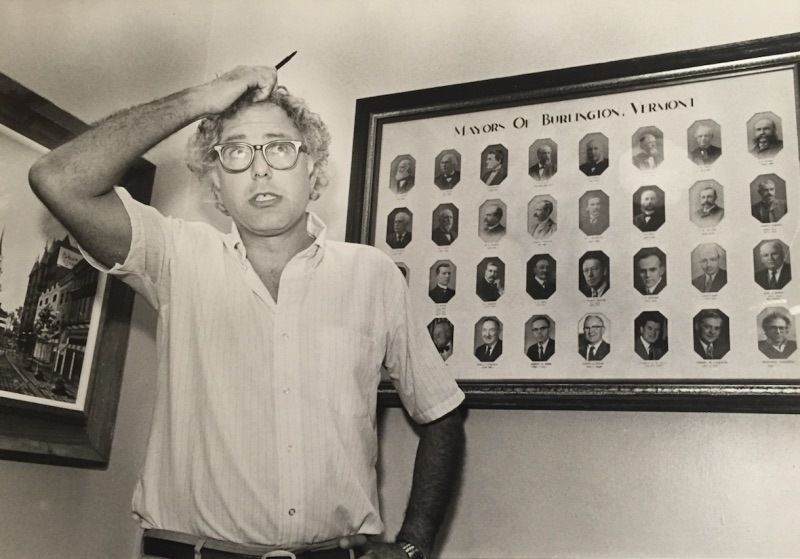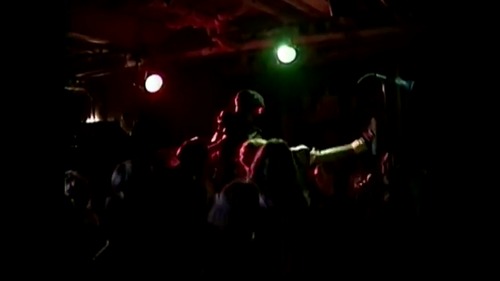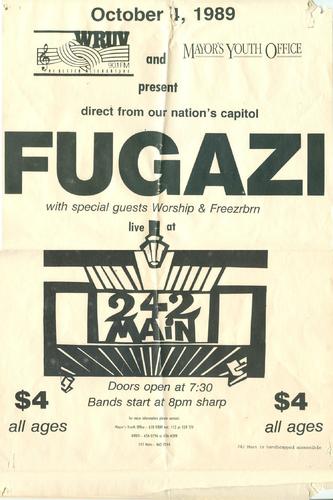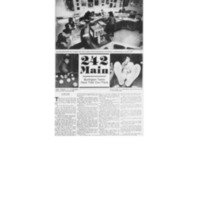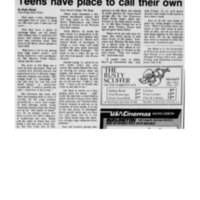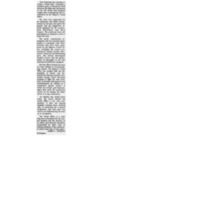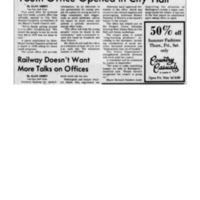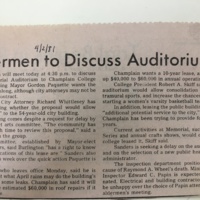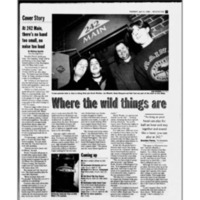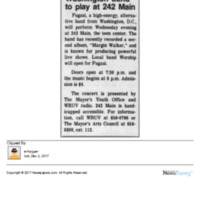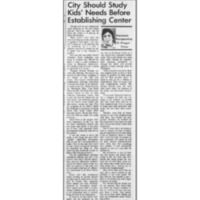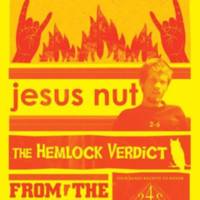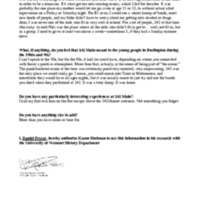Community
Upstairs
In the decades preceding the 1980's, Memorial Auditorium found itself as a local venue for a wide variety of events. Acting as a source of entertainment, cultural celebration, and consumerism, the Auditorium reached a great number within the diverse and varied population of Burlington, Vermont. During the 1980's, a shift in its utilization coincided with the political shift of the city. With greater focus on the arts and music stemming from further support of the Mayor's Art and Youth Councils, the auditorium resisted influences by other local venues that aimed to supercede it and achieve dominance as the Burlington venue. With its long history and new blood, the Memorial Auditorium would prove itself a worthy opponent to the likes of the Flynn Theater.
Sporting
During the 80's, Memorial auditorium would host both live and televised events in its main halls. With the Champlain College Basketball finding their home court at the Memorial Auditorium, residents of the Burlington area could feel a sense of pride in watching their younger generation defend their record from other schools in the region. Fans of wrestling would also find entertainment at the Auditorium, as stars the likes of Andre the Giant would duke it out as fans went wild. The sport that would bring national recognition to Burlington, however, would be boxing. Through the golden gloves tournament, which saw figters from all over Northern New England come to Memorial Auditorium, fighters of an amazing pedigree would fight in bouts that would act as the prologues to their professional careers. Those like Joey Gamache of Maine, best known for his fights with Arturo Gatti and Julio Cesar Chavez, would find the seeds of their early careers planted in the Auditorium.
Culture and Crafts
Acting as a center for the arts, music, and local crafts, the Memorial Auditorium acted as a microcosm for all levels of Burlington society and their respective cultures. Groups from the local Crafts Associaton to the Cracow Philharmonic made the main hall of the auditorium their homes, bringing both goods and entertainment of domestic and international origins to the people of Vermont. The Auditorium was also the local venue for major inter-cultural celebrations. With individual events like the Youth Goodwill Performance Group's show containing traditional Chinese song and dance, as well as collective festivals like Interfolk '86, Burlington celebrated the wide range of cultures that walked its streets.
Traditional Arts
The Auditorium was best known as a venue for the Classics during its long life. Chamber music, full orchestral ensembles, and even international giants like Yo-Yo Ma would find a stage in the small city of Burlington. The Lane Series of the University of Vermont acted as one of the largest organizers regarding the shows at the Auditorium, often conteding with the Flynn theater as both vyed for the pride of acting as host to giants of the arts. As the auditorium came under fire for its outdated interior and lack of insulation to cancel out the noises outside of the building, fewer individuals were willing to pay to hear music that traiditionally necessitated long stretches of immobility and absolute silence. One such complaint concerned the seating itself, described as being "left over from the Inquisition." With its shows being akin to torture, it was no wonder that the concerts which would dominate the remainder of the 80's would require no seating, and could drown out whatever noises came from the blocks surrounding the building.
Downstairs
The downstairs at Memorial Auditorium contained a punk and metal music venue, established in 1986 by the Mayor's Youth Office, called 242 Main. 242 Main was the center of youth culture during the late 1980s in Burlington, where music reverberated through the halls, people shared some of their most formative experiences, and the young defiantly stamped out their own place in the city. The establishment of 242 Main, and the culture that surrounded it, provides a deep example of the role that Memorial Auditorium played in defining Burlington during the 1980s, and it provides a snapshot of the place that Burlington aimed to become.
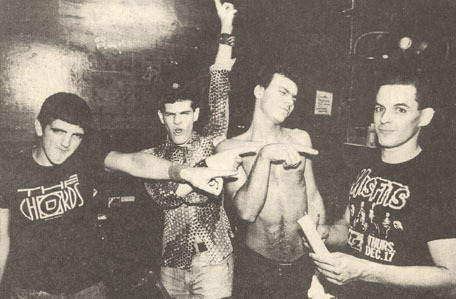
Reagan Youth, pictured here in 1983, were popular for their incendiary rhetoric against the Reagan administration
The Punk Position
Punk music started in the United States as a defiant and rebellious music genre, and throughout the 1970s, bands like the Ramones placed punk firmly in the nihlistic realm. But when bands like Black Flag and the Dead Kennedys started getting popular in the early 1980s, punk changed into an organized and explictly political genre, with songs like "Jesus was a Communist" and "Kill the Poor" having clear political messages aimed at the American right-wing, which had come to power under the Presidential administration of Ronald Reagan.[1] Punk music became primarily associated with resistance to the Reagan administration, which had an otherwise commanding lead among the broader electorate, having won reelection in 1984 by carrying 49 out of 50 states. For the city of Burlington to fund a punk music venue signalled that Burlington was positioning itself as a left-wing oasis in opposition to the president, and the story of how 242 Main got started exemplified this position.
The Mayor and 242 Main
When Bernie Sanders was elected mayor in 1980, he immediately set about enacting an agenda that set Burlington apart from the rest of the United States. He was openly pro-LGBT at a time when the LGBT community was facing intense discrimination in the midst of the AIDS crisis.[2] He was an open socialist when the Reagan administration was calling for trickle-down economics. And he championed the rebellious youth through his creation of the Mayor's Youth Office, which served as a youth voice in direct relationship with the mayor and City Council. The Mayor's Youth Office was chaired by Jane Driscoll, who would later become Mayor Sander's wife, and she was directly accountable only the mayor. Through the Mayor's Youth Office, enough funding was secured to turn the basement of Memorial Auditorium into 242 Main. The basement of Memorial Auditoruim had previously held many special collections owned by the city library, but with the construction of a new addition to the library completed in 1981, the basement was free to be used however the city wished.[3] Many ideas floated around before the city decided to turn the space into something dedicated to the youth. For a time, the space was used as a city-run day care center.[4] However, when competing private day-care centers opened with more success, the decision to turn the basement into a youth center, ran by the youth, won the day. The creation of 242 Main was controversial among the conservative in Burlington, and the idea of a youth center specifically dedicated to music and parties seemed to be a dangerous prospect for many parents. The Burlington Free Press recieved letters asking the mayor and the Youth Office to reconsider.[5] But Sanders and Jane remained defiant, and 242 Main was established in 1986, with funding from taxpayers. Despite the concern from some parents, 242 Main proved to be a rousing success among the youth, with the space filled to the brim with young people nearly every week after its establishment.[6] The experience of 242 Main for the young people in Burlington during the 1980s was formative, and recounting that experience is key to understanding the profound impact that Memorial Auditorium had on the people of Burlington.
The Experience and Its Legacy
"242 was my everything...I had my first real kiss on the fire escape above the 242/Annex entrance. Not something you forget." - Daniel Peyser, 2017[7]
242 Main defined the experience of many young people in Burlington during the 1980s. It was the place where everybody was after school and on the weekends. It was the place to see concerts, meet up with friends, and connect with other young people. It was also the most prominent place where young people were allowed to express themselves. "The walls at 242 Main are a form of teen expression," wrote the Burlington Free Press in 1986.[8] The walls were covered with art, poetry, and jokes, and the Mayor's Youth Office encouraged everybody to participate in decorating and defining the place. In addition to the punk and metal concerts, which were always a hit, 242 Main also hosted various after-school activities that allowed for other forms of teen expression. 242 Main hosted both its own youth newspaper and its own TV station, allowing budding journalists and TV anchors to learn the tools of the trade and express themselves in different ways. "It was a total dump. It was home." said Daniel Peyser, in an interview conducted in 2017.[9] 242 Main eventually became a well-known venue in the New England area, particularly as the Mayor's Youth Office started to directly recruit outside acts to come and perform there.
This culminated in the performance of Fugazi in 1989. Fugazi was a staple group of 1980s punk, and their performance marked a major milestone in the history of Memorial Auditorium and the city of Burlington.[10] The concert was sponsored by the Mayor's Youth Office, and they were able to sell tickets for $4, which was considerably less than a comparable Fugazi show in other localities. Here was Burlington, actively encouraging punk rock music and rebellious youth expression, at a time when both of those things were being attacked on the national political stage. 242 Main would continue to define the experience of young people throughout the 1990s and 2000s, even as the venue started to get dogged with numerous funding issues and scandals that eventually led to its closure in 2016. At the last punk show, the venue hung up an array of posters from the venue's history, marking the closing of a venue that helped define what it meant to be a young person in Burlington during the 1980s.

Sources
[1] Stephen Colgrave and Chris Sullivan. Punk: A Definitive Record of a Revolution. New York, NY: Thunder's Mouth Press, 2001.
[2] Gina Tron. "Mayor Bernie Sanders Created an '80s Trans Mecca in Burlington." The Daily Beast. February 29, 2016. Accessed December 02, 2017.
[3]Sally Cavanaugh. "Mahoney Wants to Increase Use of Memorial Auditorium." Burlington Free Press, July 29, 1981. Accessed December 02, 2017.
[4] Leslie Brown. "April Opening Planned for the Children's Place." Burlington Free Press, February 20, 1984. Accessed December 02, 2017.
[5] Maggie Green. "CIty Should Study Kids' Needs Before Establishing Center." Burlington Free Press, May 26, 1984. Accessed December 02, 2017.
[6] Molly Walsh. "Teens Have a Place to Call Their Own." Burlington Free Press, October 15, 1987. Accessed December 02, 2017.
[7] "Daniel Peyser Interview on 242 Main." Interview by Kason Hudman. November 15, 2017.
[8]Molly Walsh. "Teens Have a Place to Call Their Own." Burlington Free Press, October 15, 1987. Accessed December 02, 2017.
[9]"Daniel Peyser Interview on 242 Main." Interview by Kason Hudman. November 15, 2017.
[10]Mayor's Youth Office. "Washington Band to Play at 242 Main." Burlington Free Press. Accessed December 02, 2017.
